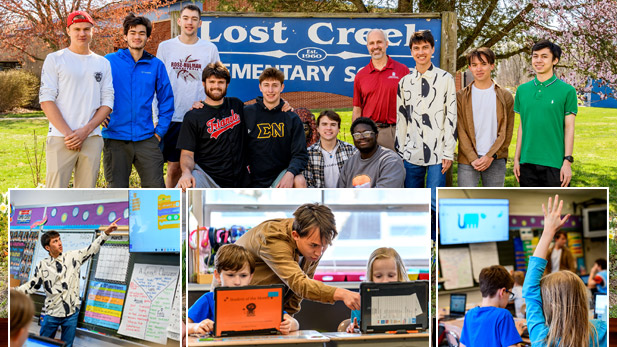Students Connecting with Community Through School Computing Partnership

Groups of students from a variety of academic majors have been leading weekly technology sessions for elementary school classrooms this school year in an educational partnership with the Vigo County School Corporation.
Rose-Hulman students have moved to the head of the class to pass along their love of computing and technology onto younger generations through a blossoming educational partnership with two Vigo County School Corporation elementary schools.
A Computer Science & Software Engineering Programming in the Community course has small groups of students leading weekly 40-minute technology sessions in third-, fourth-, and fifth-grade classrooms. The visiting students help mentor the youths on simple exercises and games by using the Scratch programming language. Some of the games have been custom-made for the classrooms.
That was the case on a Wednesday afternoon this spring, as brothers Brian and Andrew Pascente joined Adam Jirovec, Shaun Yamamoto, and Chris Lardner to meticulously guide 23 kids in a Lost Creek Elementary School third grade class to utilize simple computer programming building blocks to customize aspects of a “Save The Pets” game – selecting a variety of animals, costumes, scenic backgrounds, and sounds.
“The kids love it. They really look forward to seeing what the Rose-Hulman students are going to bring into the classroom each week,” said the class’s teacher Michaela Gauer.
The same sentiment can be found at Terre Town Elementary School, where Naa Ashifia Anum, Nyomi Morris, Endia Clark, and Remi Schwartz introduced fifth graders into simple engineering programming concepts. The Rose-Hulman students took time to help the kids reflect upon their projects, why the computer programs worked (and in some cases didn’t), and how it could be a building block for future projects.
“I'd love to incorporate more of this whenever possible. My goal is just to expose the kids to as many disciplines and possible career routes and this was a fabulous introduction to engineering,” said teacher Amy Bennett. “Naa really came into her own today (during a classroom session). You could tell that this is her jam. She was so excited and led the session with such confidence and pep. I could tell that she put thought into her lesson plans.”
Ninety Rose-Hulman students from all class years (senior through freshmen) and a variety of academic majors have made approximately 360 visits covering more than 14,000 minutes of programming instruction in 45 classrooms at the two schools this school year, under the supervision of Computer Science and Software Engineering Professor David Fisher, PhD.
It’s been a partnership that’s been a success for the VCSC schools, teachers, and students.
“Anytime we can work with Rose-Hulman, it’s to everyone’s benefit at our school. The students have been great to work with this school year,” said Lost Creek School Principal Linda Biggs. (The nationally ranked STEM college is located less than a mile from the elementary school.)
The sessions are beneficial to the Rose-Hulman students as well.
“I like it a lot. It’s great to be a good influence for younger students. Really, I get as much out of it as the kids do,” said mechanical engineering senior Ryan Krieghbaum, who is participating in the program for the first time this spring. He enjoys volunteering in the community and teaching others, usually in his hometown church Sunday School classes. “It’s neat to see the kids’ eyes light up when they have completed the steps properly and a program works. I’m delighted too.”
Mechanical engineering classmate Souley Cissokho has tutored high school students, but this is his first experience working with elementary school-aged youths. “The kids like projects that have visuals and sounds. We make sure the lessons are relatable to the kids and keep them interested in the entire (40-minute) classroom period,” he stated.
“I like seeing the kids getting interested in something that we’re involved in (computing),” remarked Ash Collins, a junior computer science student who is leading sessions for the third academic quarter this spring. “Hopefully, these classes will inspire them to do more coding.”
Encouraging the next generation of STEM professionals is a secondary goal of the program, according to Fisher. “Computers and computing are going to be a big part of the (VCSC) students’ world. We want to get them to embrace technology and take advantage of these computing tools that they have at their fingertips,” said the professor.